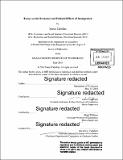Essays on the economic and political effects of immigration
Author(s)
Tabellini, Marco (Marco E.)
DownloadFull printable version (19.33Mb)
Other Contributors
Massachusetts Institute of Technology. Department of Economics.
Advisor
Daron Acemoglu and Heidi Williams.
Terms of use
Metadata
Show full item recordAbstract
This thesis consists of three chapters on the economic and political effects of in-migration. In the first chapter, I show that political opposition to immigration can arise even when immigrants bring significant economic prosperity to receiving areas. I exploit exogenous variation in European immigration to US cities between 1910 and 1930 induced by World War I and the Immigration Acts of the 1920s, and instrument immigrants' location decision relying on pre-existing settlement patterns. Immigration increased natives' employment and occupational standing, and fostered industrial production and capital utilization. However, despite these economic benefits, it triggered hostile political reactions, such as the election of more conservative legislators, higher support for anti-immigration legislation, and lower public goods provision. Stitching the economic and the political results together, I provide evidence that natives' backlash was, at least in part, due to cultural differences between immigrants and natives, suggesting that diversity might be economically beneficial but politically hard to manage. The second chapter asks the following question: is racial heterogeneity responsible for the distressed financial conditions of US central cities and for their limited ability to provide even basic public goods? If so, why? I study these questions exploiting the movement of more than 1.5 million African Americans from the South to the North of the United States during the first wave of the Great Migration (1915-1930). Black immigration and the induced white outmigration ("white flight") are both instrumented for using, respectively, pre-migration settlements and their interaction with MSA geographic characteristics that affect the cost of moving to the suburbs. The inflow of African Americans imposed a strong, negative fiscal externality on receiving places by lowering property values and, mechanically, reducing tax revenues. Unable or unwilling to raise tax rates, cities cut public spending, especially in education, to meet a tighter budget constraint. While the fall in tax revenues was partly offset by higher debt, this strategy may, in the long run, have proven unsustainable, contributing to the financially distressed conditions of several US central cities today. The third chapter, coauthored with Michela Carlana, studies the effects of immigration on natives' marriage, fertility, and family formation across US cities between 1910 and 1930. Instrumenting immigrants' location decision by interacting pre-existing ethnic settlements with aggregate migration flows, we find that immigration raised marriage rates, fertility, and the propensity to leave the parental house for young native men and women. We show that these effects were driven by the large and positive impact of immigration on native men's employment and occupational standing, which increased the supply of "marriageable men". We also explore alternative mechanisms - changes in sex ratios, natives' cultural responses, and displacement effects of immigrants on female employment - and provide evidence that none of them can account for a quantitatively relevant fraction of our results.
Description
Thesis: Ph. D., Massachusetts Institute of Technology, Department of Economics, 2018. Cataloged from PDF version of thesis. Includes bibliographical references.
Date issued
2018Department
Massachusetts Institute of Technology. Department of EconomicsPublisher
Massachusetts Institute of Technology
Keywords
Economics.